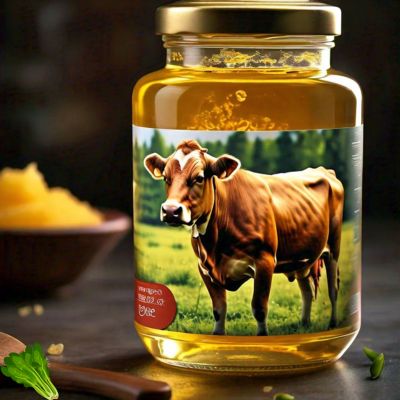Ghee, a type of clarified butter, has long roots in Indian culinary traditions and Ayurveda. It’s made by cooking butter to separate milk solids and water from the fat, producing a rich, nutty flavor profile that stands out from regular clarified butter. Cooking ghee for a longer time than other clarified butters allows the milk solids to caramelize, enhancing its unique taste.

Nutritional Composition and Benefits of Ghee
For thousands of years, ghee has been central in Ayurvedic medicine, attributed with various health benefits. Advocates of Ayurveda believe that the clarification process removes impurities, creating a purer form of fat that may offer specific health advantages. While research is still emerging, ghee is often used in moderation to add richness to foods and may provide benefits in certain contexts.
Here’s a breakdown of the nutrition in one tablespoon (15 grams) of ghee, according to USDA data:
- Calories: 130
- Total Fat: 15g
- Saturated Fat: 9g
- Monounsaturated Fat: 5g
- Polyunsaturated Fat: <1g
- Protein: 0g
- Carbohydrates: 0g
- Sodium: 0mg
- Vitamin A: 107.5mcg (8% of RDI)
- Vitamin E: 0.4mg (2% of RDI)
- Vitamin K: 1.1mcg (1% of RDI)
Given its high-fat concentration, ghee is a calorie-dense food, best used in small amounts. Unlike regular butter, ghee has a high smoke point, making it suitable for cooking at higher temperatures without breaking down into harmful compounds.
Carbohydrates
Since ghee is nearly pure fat, it has no carbohydrates. This makes it a viable option for those following low-carb or ketogenic diets, as it can add flavor and healthy fats without affecting blood sugar levels.
Fats
One tablespoon of ghee contains about 15 grams of fat, primarily from saturated fats, but also includes beneficial monounsaturated fats. These fats support essential functions in the body, such as absorbing fat-soluble vitamins and supporting cellular structures. However, due to its high saturated fat content, experts recommend using ghee in moderation as part of a balanced diet.
Protein Content
Since milk solids are mostly removed during clarification, ghee contains minimal protein. However, trace amounts may remain depending on the thoroughness of the clarification process.
Vitamins and Minerals
Ghee provides some essential vitamins, particularly fat-soluble vitamins A, E, and K. While not significant enough to meet daily nutritional needs, these vitamins are beneficial in small quantities. When used to cook vegetables and other nutrient-dense foods, ghee can enhance the absorption of these fat-soluble vitamins, making your meal both flavorful and nutritionally enriched.
Potential Health Benefits of Ghee
While ghee is a popular ingredient for flavor, some people use it for health purposes. Ayurvedic medicine suggests that ghee may support memory, joint flexibility, and digestion. Scientific evidence on these benefits is still inconclusive, especially in human studies, but there are a few promising areas:
Skin Healing Properties
Aside from cooking, some use ghee topically for its purported soothing qualities on burns, rashes, and wounds. Ghee contains antimicrobial and antioxidant properties due to its vitamin A and E content, making it beneficial for skin health. In some studies, ghee has been used with honey, another natural remedy, to enhance its skin-healing effects.
Lower Exposure to Acrylamide
When exposed to high heat, many cooking oils can produce acrylamide, a compound linked to adverse health effects. Ghee has a high smoke point of around 482°F (250°C), meaning it produces less acrylamide compared to other oils when heated, which may make it a healthier choice for frying and sautéing.
May Be Tolerable for People with Dairy Sensitivities
Although ghee is derived from butter, the clarification process removes most lactose and casein, which are often the culprits behind dairy sensitivities. This may allow individuals with mild lactose intolerance to enjoy ghee without discomfort. However, people with severe dairy allergies should consult a healthcare provider before trying ghee to ensure it is safe for them.
Possible Side Effects and Considerations
Despite its many uses, ghee is high in saturated fat, which can affect heart health if consumed excessively. Health guidelines recommend limiting saturated fat intake to less than 10% of daily calories. People with high cholesterol or heart disease should consider even lower intake, ideally less than 5–6% of daily calories. Since one tablespoon of ghee contains 40mg of cholesterol, it’s best used as a supplement to enhance food flavors rather than as a primary fat source.
Types and Varieties of Ghee
Traditional ghee is made from cow’s milk butter, but it is also sometimes made with buffalo milk, especially in parts of South Asia. Some brands offer flavored ghee infused with spices like turmeric, but it’s generally more versatile to use plain ghee and add spices separately, tailoring the flavor to each dish.
When choosing ghee, ensure it’s genuinely clarified butter, as some products labeled “ghee” might be made from vegetable oils, which do not have the same nutritional properties or flavor.
Storage and Shelf Life
Ghee is typically sold in resealable glass jars and can be stored at room temperature, where it lasts up to three months in a cool, dark place. Refrigerating ghee can extend its shelf life to a year, though it may solidify when chilled. Simply allow it to warm to room temperature before using, and it will regain its smooth, pourable consistency.
Cooking and Using Ghee
Because of its distinct nutty flavor and oily texture, ghee can’t always replace butter directly, particularly for baking, where its texture can yield crisper results. In cooking, however, ghee’s high smoke point makes it ideal for frying, sautéing, and roasting, where it brings a rich, deep flavor to dishes. Here are some ideas on how to incorporate ghee into your meals:
- Sauté Vegetables: Use a small amount of ghee to sauté spinach, bell peppers, or other vegetables, adding both flavor and nutritional benefits.
- Stir Fry: Ghee works well in high-heat stir fry dishes like chicken fried rice, adding a rich layer of flavor and keeping acrylamide formation to a minimum.
- Indian Dishes: For an authentic touch, try ghee in traditional Indian recipes, such as curries, dals, or palak paneer, to enhance the taste and aroma.
- Alternative to Oils: Ghee can also replace other cooking oils for roasting vegetables, marinating meat, or pan-frying, giving foods a deliciously complex taste.
Getting Started with Ghee
If you’re new to ghee, start by using it in dishes where its flavor will shine, such as sautéed vegetables or curries. Many people find that ghee adds a comforting, home-cooked aroma to foods, and once you’ve mastered its use in savory dishes, you can experiment with incorporating it into baked goods or desserts.
Final Thoughts
Ghee is a versatile and flavorful alternative to butter and oils in cooking. It brings traditional Indian flavors to the table while providing a high smoke point for safe high-heat cooking. Although it’s rich in fat, using ghee sparingly can help add depth to various dishes while keeping its health impact in check. Whether you’re using it for culinary exploration or considering its potential health benefits, ghee remains a valuable addition to the kitchen for anyone looking to expand their cooking repertoire.
[Read more : Honey : Nutritional Benefits & Health Impacts]
***********************
Frequently Asked Questions
Q1. Is ghee healthy to include in a daily diet?
Answer : Yes, in moderation. Ghee provides beneficial fats and fat-soluble vitamins like A, E, and K. Its high smoke point makes it suitable for cooking at high temperatures without harmful oxidation.
Q2. How much ghee should one consume daily?
Answer : One teaspoon to one tablespoon per day is generally recommended. This provides the flavor and benefits without excessive saturated fat intake.
Q3. Can lactose-intolerant individuals consume ghee?
Answer : Ghee contains minimal lactose, making it usually tolerable for those with lactose intolerance. However, those with severe dairy allergies should consult a doctor.
Q4. Does ghee help with digestion?
Answer : Yes, ghee contains butyrate, a fatty acid that supports gut health and digestion.
Q5. Is ghee better than butter for cooking?
Answer : Yes, ghee has a higher smoke point (482°F) than butter, which makes it better for high-heat cooking like frying and roasting.
Q6. Can ghee aid in weight loss?
Answer : When used in moderation, ghee can aid satiety and help absorb nutrients, but it’s calorie-dense, so portion control is key.
Q7. What nutrients does ghee provide?
Answer : Ghee provides vitamins A, E, and K and is a source of healthy fats, especially monounsaturated fats.
Q8. Can ghee support skin health?
Answer : Yes, its antioxidant properties can benefit skin when consumed or applied topically.
Q9. Does ghee raise cholesterol?
Answer : Ghee is high in saturated fat, so excessive use may impact cholesterol. It’s best to use in moderation.
Q10. Is ghee suitable for keto diets?
Answer : Yes, ghee is nearly pure fat and is a great option for keto, adding flavor without carbohydrates.
